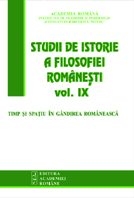Timp şi eternitate în Sacrosanctae scientiae indepingibilis imago de Dimitrie Cantemir
Time and eternity in Cantemir’s Sacrosanctae scientiae indepingibilis imago
Author(s): Dragoş POPESCUSubject(s): Philosophy
Published by: Editura Academiei Române
Keywords: Time; eternity; ens; singularity; universality
Summary/Abstract: The present study examines Dimitrie Cantemir’s conception of time, conceived around 1700 in Constantinople and published in his Sacrosanctae scientiae indepingibilis imago. In the mentioned writing, the Moldavian prince developed an alternative to the neo-Aristotelian physics of his age which was being promoted by the representatives of post-Byzantine culture in Constantinople and the sources of which were Teophilos Korydalleus’ commentaries to Aristotle’s works. Cantemir strongly discouraged the attempts of introducing that understanding of physics in the Eastern Orthodox thinking. In shaping his own “theologo-physics”, he aimed to keep unaltered the Eastern Orthodox belief which he thought threatened by the pagan philosophy illegally integrated into the Scholastic thinking. In order to reach his goal, Cantemir didn’t hesitate to resort to the terminological resources of Van Helmont’s theosophy, hostile to Scholasticism as well. In this framework, Cantemir offers an original point of view according to which time is defined as ens (singular universality and universal singularity) and is distinct from duration, the latter being a measurable conventional interval of natural development.
Journal: Studii de istorie a filosofiei româneşti
- Issue Year: IX/2013
- Issue No: 09
- Page Range: 41-56
- Page Count: 16
- Language: Romanian

